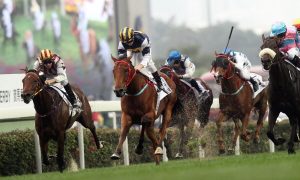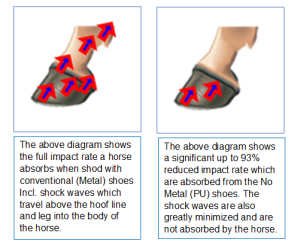 Linda Krueger (Author)
Linda Krueger (Author)
It often tears the blood vessels of ambitious horses. High blood pressure and the impact of the front hooves during the race are to blame.
For the assessment, a racehorse was monitored during high-speed racing. The data collected showed the “moment of impact” at an astonishing rate of 1, 800.00 Kg (3,968.32 pounds) when the front hooves touch the ground. once would ask if training stops and/or impact-absorbing hoof protection would help to reduce or prevent EIPH.

SYMPTOMS
In milder cases, the horse coughs after heavy exertion and swallows even though it has neither eaten nor drunk, nor needs longer periods of calming. “Even at rest, the respiratory rate is slightly increased, about 14 instead of 8 breaths or 18 instead of 14,” says lung specialist Dr. Heike Kuehn, a veterinarian at the horse clinic Munich – Riem / Bavaria
In heavy cases, the horse in the race becomes relatively slower or stops.
Then it also bleeds from the nose, according to Dr. Heike Kuehn. Overall, however, nosebleeds (epistaxis) are very rare. Sometimes the disease develops only in a seemingly inexplicable low performance even cases without visible symptoms are possible.
CAUSES
The cause of Exercise Induced Pulmonary Hemorrhage (EIPH) is not exactly known. Presumably, there are several factors for the bleeding, which occurs almost exclusively in the upper, posterior part of the lungs. One may be high blood pressure in the small blood vessels of the lungs. During extreme exertion, such as high-speed races, the pressure rises from a resting value of 25 millimeters of mercury (mmHG) to up to 90 mmHG; most animal species have a maximum value of 35 mmHG. Due to the pressure, the capillaries rupture, so blood enters the pulmonary bladders and lung tissue. “That can be 200 milliliters, but also significantly more, like a jumping horse that bled so badly after the last jump that the rider had red trousers,” says Dr. Kuehn. Rarely, blood flows by the liter until it bleeds to death.
According to a recent theory, there could also be a connection with the impact of the front hooves at high speed. When they hit the ground, the respective shoulder is pressed hard against the rib box. This creates pressure waves that continue into the lungs. They are particularly intense in the posterior, narrower lung area, where the capillaries tears.
CONSEQUENCES
The lung tissue depletes, which can lead to severe lung conditions such as recurrent airway obstruction (RAO). “The blood pulp in the lungs is a good breeding ground for infections,” says Dr. Heike Kuehn. In severe cases, the horse’s performance can be so severely restricted that it must no longer be heavily loaded. “With ambitious horses, there may also be effects on the psyche, as they can no longer do what they want.”
TREATMENT
In the USA, stress pulmonary bleeding is often treated with a furosemide preparation (Lasix), which has a diuretic and hypotensive effect. Outside the USA and Canada, this is prohibited doping. The effect of furosemide is controversial. A new US drug (EIPH-Nox) for the treatment and prevention of pulmonary bleeding is also doping in Europe, “like all nitro oxide preparations,” says Dr. Kuehn. Instead, she gives post-race vitamin C as a radical measurement and high-dose cortisone to reduce the inflammation reaction and, if necessary, mucus dissolver. Dr. Kuehn also recommends training breaks in which the horses are not challenged to the maximum. “Vitamin K is not useful in my view, because these horses have no blood clotting disorder.”
A new U.S. drug (EIPH-Nox) for the treatment and prevention of pulmonary bleeding is also doping in Europe, like all nitro-oxide medication, says Dr. Kuehn. However, after the race, to instigate vitamin C as a radical thread and high-dose cortisone to reduce the inflammation reaction and, if necessary, mucus dissolver. Dr. Kuehn also recommends training breaks in which the Horses are not required to the maximum. “Vitamin K is not useful from my point of view because these horses have no blood clotting disorder”, she added.
ALTERNATIVE TREATMENT
Animal healer Julia Melanie Hahlweg from Wiel, Baden-Wuerttemberg treats sudden bleeding and loss of performance homoeopathically first with Aconite; then she gives arnica. “This is one of the best means. It has an immediate and lasting effect.” Ferrum phosphoricum and ipecacuanha are effective against debilitating changes in the mucous walls of the lungs and against irritated mucous walls with bleeding tendencies during exercise and shortness of breath.
TREATMENT TIME
Itdependsonthedegreeofbleeding.After that, the training breaks must also be coordinated, in which the lungs must not be stretched to the maximum.”Thisisusuallybetweentwoandfourweeks,” says Dr. HeikeKuehn.For control, the measurement of the respiratory rate must be normal before maximum load. Whether the lung tissue regenerates completely depends on the degree and frequency of bleeding. Usually, of course, impatient trainers and owners prevent the complete healing.” In sports, it’s often said: We can’t wait four weeks,” says Dr. Kuehn.
PREVENTION
There is no safe method. It is important to protect the respiratory tract with plenty of fresh air, a low-dust environment, and low-dust food. Accidental horses should not be trained behind other horses because of the dust. Veterinarian Kuehn also advises on full polyurethane (No Metal) hoof protection for better shock absorption and on hard ground to dispense with maximum training or sometimes a start: “If horses are used specifically for races and have rest breaks in between, severe consequences can often be avoided.” In the case of soft palate displacement, the conversion to a bitless bridle can also help.
























































